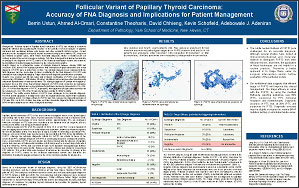Follicular Variant of Papillary Thyroid Carcinoma: Accuracy of FNA Diagnosis and Implications for Patient Management
Berrin Ustun, Ahmed Al-Omari, Constantine Theoharis, David Chhieng, Kevin Schofield, Adebowale J. Adeniran
Department of Pathology, Yale School of Medicine, New Haven, CT, USA
ABSTRACT
Background:
Follicular Variant of Papillary thyroid carcinoma (FVPTC) has created a continuous diagnostic dilemma among pathologists because of the paucity of nuclear changes of papillary carcinoma and overlapping features with benign and other neoplastic follicular lesions. Current guidelines for the management of thyroid nodules recommend surgery for confirmed PTC, suspicious and follicular neoplasm cases, while further immediate diagnostic studies or treatment are not routinely required if the nodule is benign on cytology. This study is designed to determine the accuracy of cytology in the diagnosis of FVPTC, based on the Bethesda classification system and determine the implications for patient management based on the current recommendation.
Design:
Based on a retrospective review of cytologic diagnosis between January 2008 and December 2010, thyroid FNA cytology specimens with subsequent surgical intervention and a final diagnosis of FVPTC were selected from our files. The cytologic diagnoses were compared with the final diagnoses and the percentage of cases contributing to the final diagnosis of FVPTC was calculated for each diagnostic category. Triage efficiency and diagnostic accuracy were calculated.
Results:
One hundred and fifty two cases with histologic confirmation of FVPTC were identified (representing 128 patients – 100 females, 28 males). All patients had undergone either lobectomy with completion thyroidectomy or total thyroidectomy. The cytologic diagnosis of “positive for malignancy” accounted for only 26% of the final histologic diagnosis of FVPTC while suspicious for carcinoma, follicular neoplasm, follicular lesion of undetermined significance and benign accounted for 11%, 22%, 22%, 15% of the final diagnosis of FVPTC, respectively. Non-diagnostic cytologic cases accounted for the remaining 4%. Only 18% of the 55 cases tested were positive for BRAF mutation.
Conclusion:
The subtle nuclear features of FVPTC pose challenges for an accurate diagnosis. Therefore a better approach is to triage these cases for surgical intervention and/or further evaluation of the particular nodule. Our triage efficacy for FVPTC was 84%, however the diagnostic accuracy of PTC was 38%. Up to 15% of cases may have no further immediate diagnostic studies or treatment. BRAF mutation analysis has no effect on diagnostic accuracy.
©2012 Yale Department of Pathology. All rights reserved.
Any redistribution or reproduction of part or all of the contents in any form is prohibited. You may not, except with express written permission of the author or the Department of Pathology, distribute or commercially exploit the content, nor may you transmit it or store it in any other website or other form of electronic retrieval system, including use for educational purposes.
